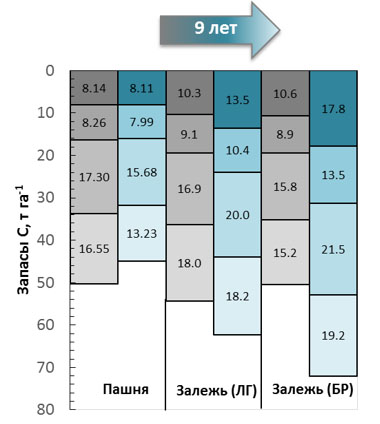Spatio-temporal analysis of soil indicators of the carbon cycle in some postagrogenic ecosystems of the southern Moscow region
DOI:
https://doi.org/10.31251/pos.v7i3.261Keywords:
arable land; abandoned land; carbon stocks; microbial biomass reserves, basal respiration.Abstract
The aim of the study. The purpose of this work was to analyze changes over time in soil and soil microbial biomass carbon content, basal respiration, as well as the availability of organic matter for microbial decomposition, in Phaeozem of postagrogenic and arable ecosystems.
Location and time of the study. Moscow region, Pushchino, experimental field station of the Institute of Physicochemical and Biological Problems in Soil Science of the Russian Academy of Sciences, June 2023.
Methods. The study was carried out with soils under different land use: arable land, abandoned land under meadow vegetation and abandoned land under young birch forest. For each type of land use, geobotanical descriptions were done, and soil samples were taken from the upper part of soil profiles (0–30 cm in 5 cm increments) at four spatially distant points. In soil samples, the content of total carbon (C), the C:N ratio, the content of microbial biomass (Cmic) and basal respiration (BR) rate were measured. Taking into account the soil density, the C and Cmic reserves in the 0-30 cm layer were assessed.
Results. The highest soil C reserves in the 0–30 cm layer after nine years were under the abandoned land with young birch forest (72 t C ha-1), whereas the lowest reserves (45 t C ha-1) were in arable soils. The actual rate of C accumulation at abandoned sites could be 0.9 and 2.4 t C ha-1 year-1 for the meadow forbs and young forest, respectively. Over the 9-year period the C:N ratio at abandoned sites increased by 1,2–1,5 times in the upper 5 cm layer. The C:N ratio decreased with depth. Soil BD in the 0–10 cm soil layer decreased in the following order: abandoned site with meadow herbs – abandoned site with young birch forest – arable land. There was a tendency to increased BD:C in the upper 5 cm soil layer at arable and abandoned (with meadow herbs) sites by 1,2 times over the observed period (from 49 to 60 μg C g-1 C h-1 and from 52 to 67 μg C g-1 h-1, respectively). For an abandoned site with a young birch forest, the opposite trend was revealed, i.e. a decrease in BD:C by 1,9 times (from 74 to 39 μg C g-1 C h-1).
Conclusions. The conversion of arable land into the abandoned one occupied by meadow or young forest vegetation, both in the chronosequence and after nine years of spontaneous revegetation, leads to the soil C accumulation, especially in the upper part of the former arable horizon.
Downloads

Downloads
Published
How to Cite
Issue
Section
License
Copyright (c) 2024 The Journal of Soils and Environment

This work is licensed under a Creative Commons Attribution 4.0 International License.






